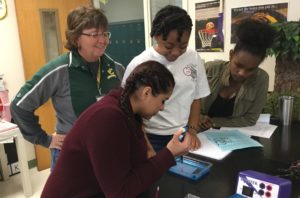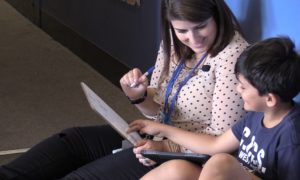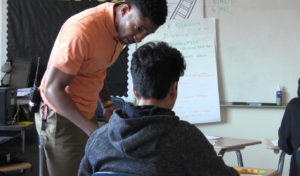As part of a deep look at how schools rethink how they are organized to address each student’s needs, Public Impact and the Clayton Christensen Institute today released the second set of profiles of schools and teachers using innovative staffing with blended learning. These profiles, many with accompanying videos, set the stage for an upcoming white paper analyzing the patterns of the schools’ and teachers’ experiences.
We focused on schools or school networks serving disadvantaged populations that achieved better-than-typical student learning and provided students with more personalized experiences while using new staffing models and blended learning.
The profiles released today:

In Cabarrus County, N.C., Lori Treiber and Scott Nolt are blended-learning teachers at Central Cabarrus High School and Jay M. Robinson High School, respectively, in the Cabarrus County Schools district. Each uses a mix of in-person teaching and online learning—either at home or school—to reach twice as many students within a specific class period as they would otherwise. Both teachers focus their in-person time with students on small-group and individual work, allowing them to personalize instruction and give students more choice and control over their learning. They receive salary supplements for reaching more students that are funded solely through each school’s regular budgets. Their roles were designed under the national Opportunity Culture initiative.

CICS West Belden is a K–8 charter school that is part of the Chicago International Charter School network managed by Distinctive Schools, whose mission is to serve students in underserved communities. The school focuses on ensuring that all students receive consistent, high-quality instruction and have strong, caring relationships with multiple adults at school through a combination of small-group instruction, online learning, and four main teaching roles: instructional coach, mentor teacher, career teacher, and resident teacher. Funding for these roles comes mostly through the school’s state and federal funding, plus some grants.

Intrinsic Schools provides personalized instruction using a combination of online learning and team teaching in math and English. The Chicago charter school’s staffing arrangement gives students personalized instruction and supportive relationships from multiple adults, while fostering teacher development through co-teaching. Intrinsic teachers also receive formal and informal coaching and mentorship from other teachers or administrators. Intrinsic pays its staff within its state-allocated budget, and uses grants to fund new building construction, extra professional development, and student field trips.

Ranson IB Middle School, an Opportunity Culture and International Baccalaureate school in the Project L.I.F.T. zone of Charlotte-Mecklenburg Schools, provides personalized instruction using a combination of multi-classroom leaders, small-group teaching, online learning, and a focus on in-the-moment instructional adjustments according to each student’s needs. Multi-classroom leaders (MCLs) extend the reach of their excellent teaching to more students by leading small teaching teams. MCLs at Ranson write the lesson plans for their teams, co-teach and model lessons, pull out small student groups, observe and coach their team teachers, and lead data analysis for instructional and grouping adjustments. Ranson provides higher pay for multi-classroom leaders solely through reallocations of its budget.
All eight profiles, which also include a private school, look at the schools from both the teachers’ and students’ perspectives. They show how the schools adjusted or built their facilities to accommodate their staffing models, and how they fund their teachers’ and teacher-leaders’ pay.
And keep an eye out for our joint analysis, coming soon, with Clayton Christensen Institute of common and promising elements from these schools innovating with staffing and blended learning to personalize instruction.
